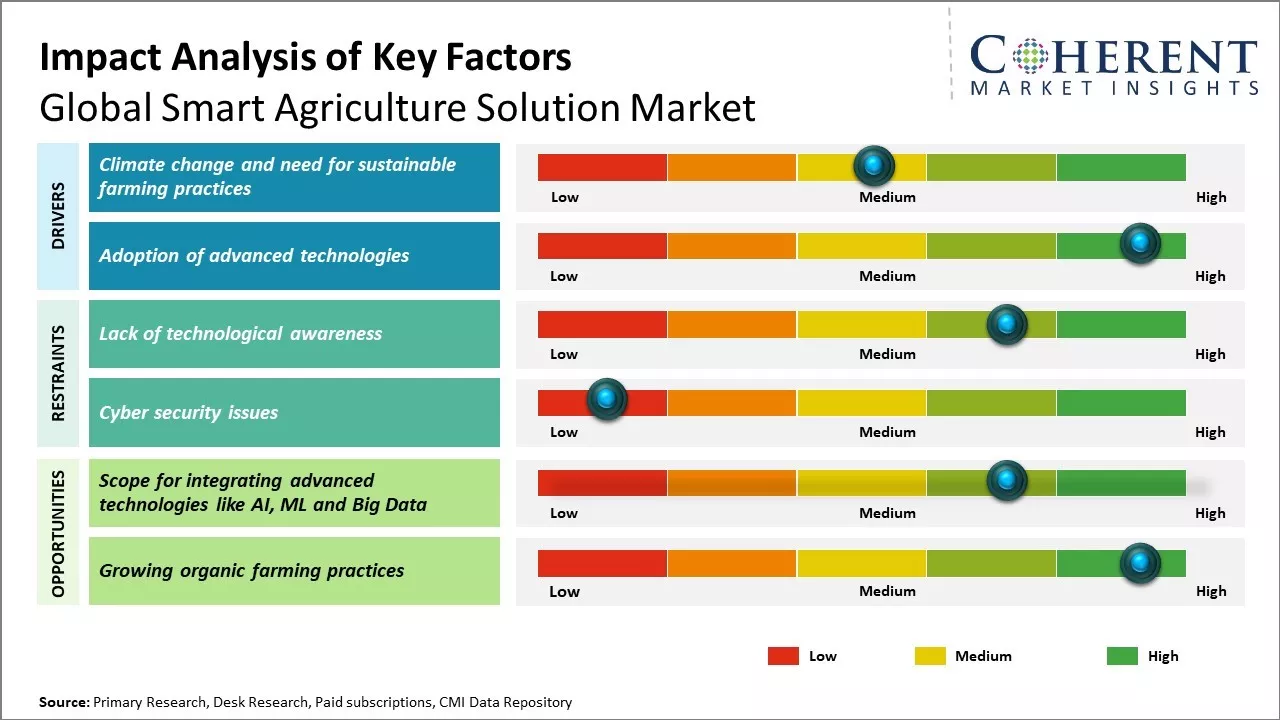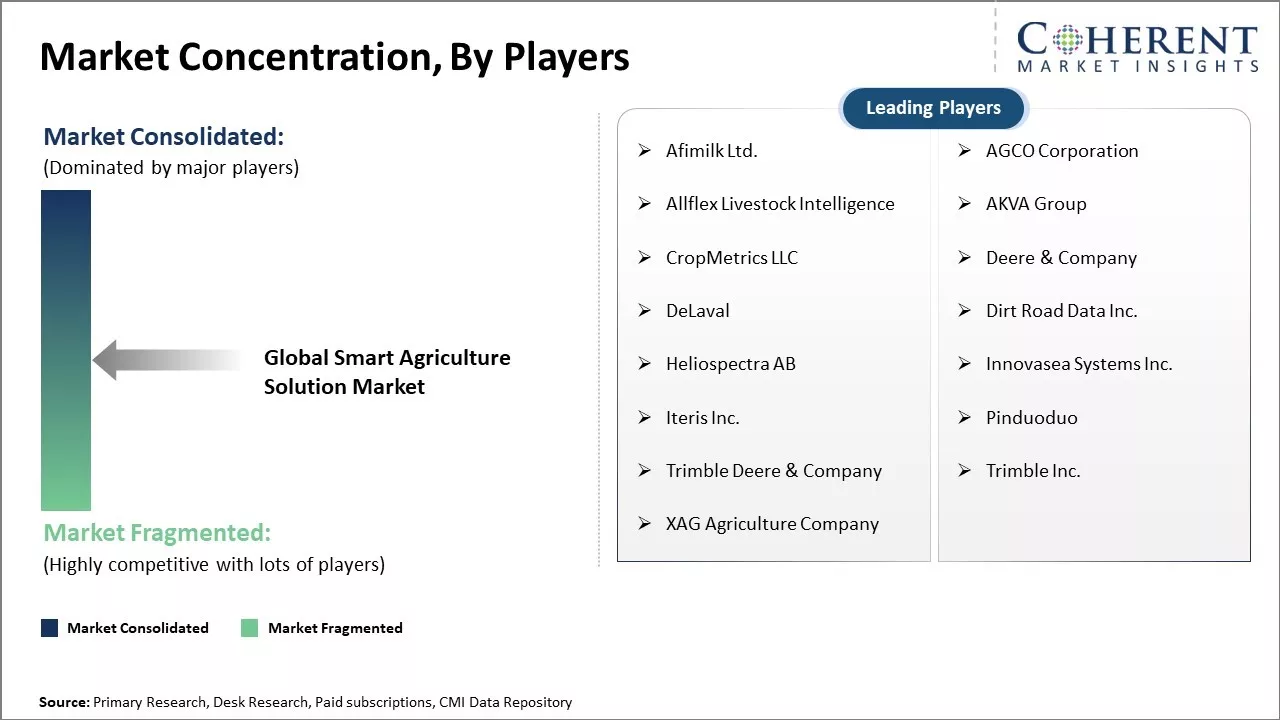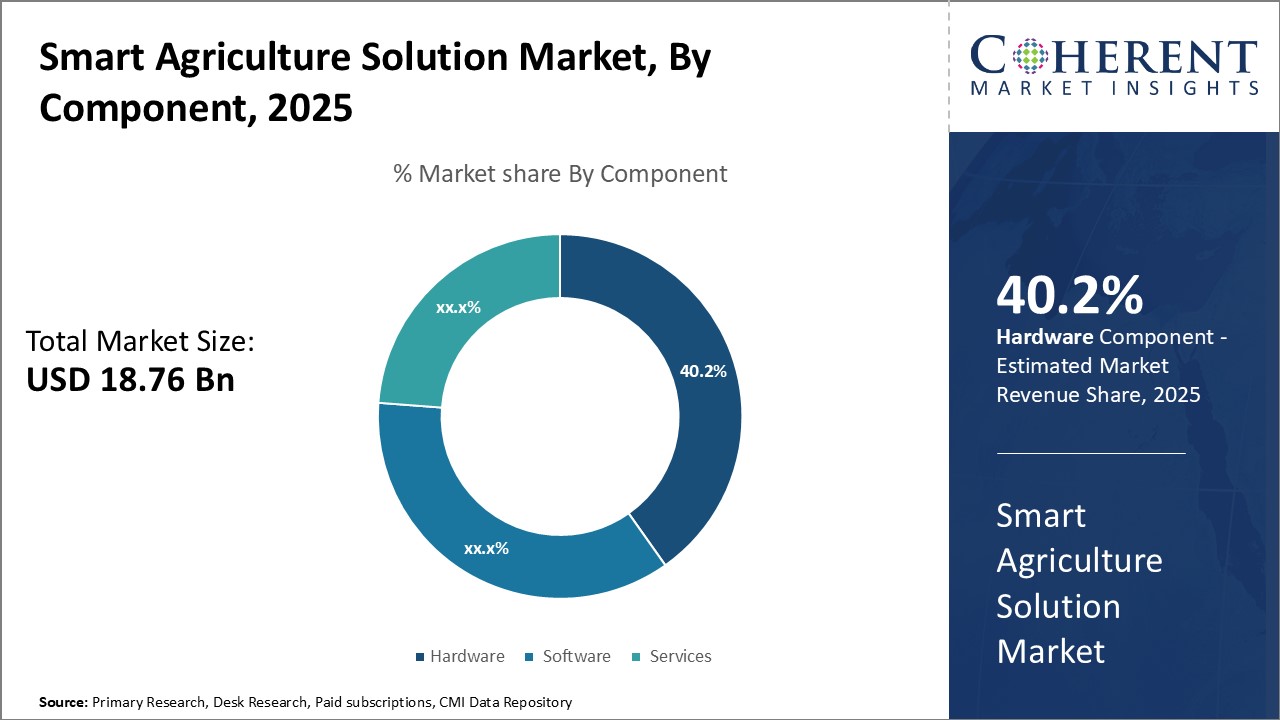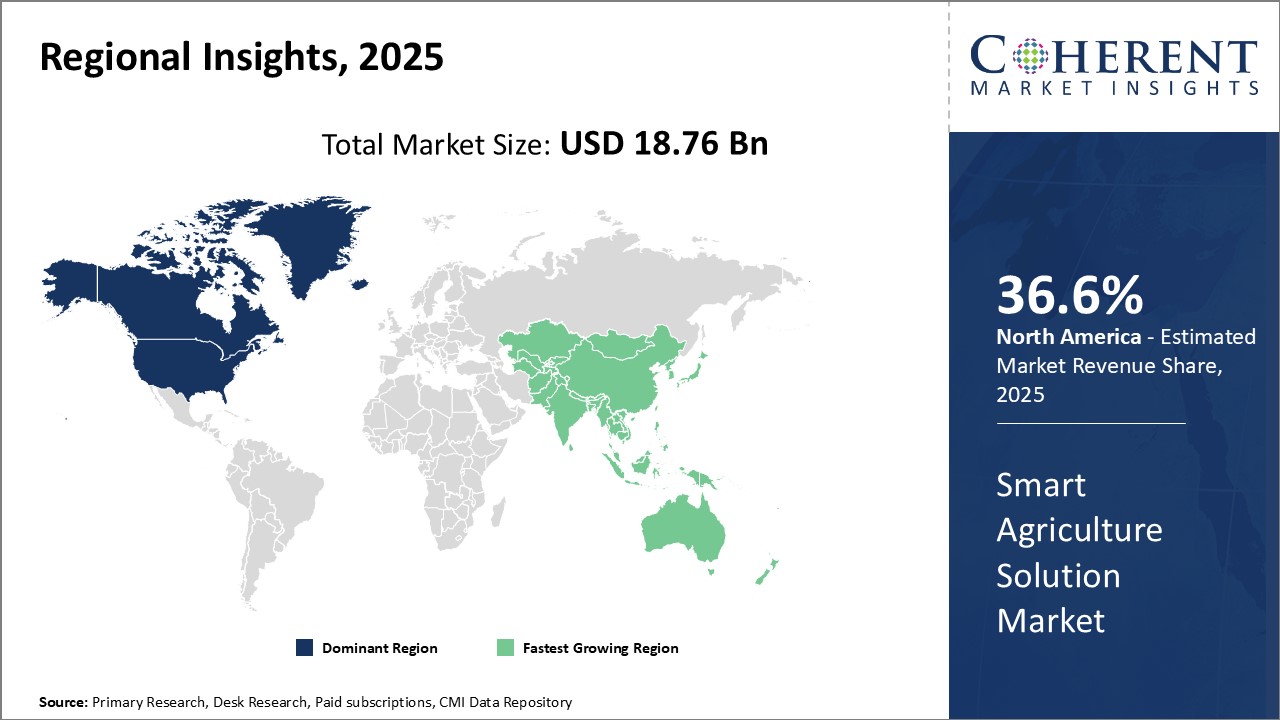The Global Smart Agriculture Solution Market is estimated to be valued at US$ 18.76 Bn in 2025 and is expected to reach US$ 39.47 Bn by 2032, exhibiting a compound annual growth rate (CAGR) of 11.2% from 2025 to 2032.

Discover market dynamics shaping the industry: Download Free Sample
Smart agriculture solutions include hardware, software, and services that help farmers monitor their fields remotely, optimize resources, and minimize waste using technologies such as drones, sensors, AI, and analytics. The adoption of smart agriculture solutions is expected to increase significantly over the coming years. Driven by the need to boost productivity and maximize crop yields, farmers are increasingly using sensors, data analytics, and other smart technologies to gain real-time insights into field conditions. This helps them make better-informed decisions regarding irrigation, pesticides, and fertilizer use. The trend towards precision and digital farming is expected to continue and drive the growth of the smart agriculture solution market during the forecast period.
Climate change and need for sustainable farming practices
One of the major drivers for the growth of the global smart agriculture solution market is the increasingly adverse impacts of climate change on conventional farming practices. Extreme weather events such as droughts, floods, and unpredictable rainfall patterns are occurring more frequently in various parts of the world. This is affecting crop yields and reducing the productivity of farms significantly. At the same time, the growing world population is putting immense pressure on available agricultural land and water resources to meet the rising global food demand.
Farmers are needing innovative solutions to adapt to these climate challenges and make their farms more sustainable and resilient. Smart agriculture offers various technologies that can help farmers monitor field conditions, optimize the use of resources like water and fertilizers, and automate agricultural processes.
For instance, in October 2022, Trimble Inc., an American software, hardware, and services technology company launched new agriculture displays that offer next-generation capabilities. These advanced displays equip farmers with enhanced functionality, including improved connectivity, intuitive user interfaces, and integrated precision agriculture features. This enables farmers to optimize their farming operations and boost productivity.

Get actionable strategies to beat competition: Download Free Sample
Adoption of advanced technologies
Drones and computer vision tools are playing a major role in gathering field data non-invasively. High-resolution images captured by drones can be analyzed using advanced algorithms to detect plant diseases, monitor crop growth stages, map soil nutrient deficiencies, and spot pests or weeds. Armed with such actionable insights, farmers can take prompt actions to improve farm management practices, maximize productivity even in adverse conditions, and boost farm profitability over the long term in a sustainable way. The ability of smart agriculture solutions to build climate resilience on farms and optimize resource-use is a key factor driving many farmers and governments across regions to adopt emerging smart technologies.
Key Takeaways from Analyst:
The major drivers for the smart agriculture solution market growth are the rising need to monitor crops remotely and optimize crop production. Adoption of IoT and AI technologies in the agricultural sector is increasing at a rapid pace. Precision agriculture tools that help farmers monitor soil and crop health and optimize water and fertilizer usage are seeing higher demand.
North America currently dominates the market due to extensive government support for smart farming. However, Asia Pacific is expected to emerge as the fastest growing region due to the huge agricultural economy and increasing focus on maximizing yields.
High initial investment remains a key restraint for the larger scale adoption of smart agriculture solutions. Lack of proper infrastructure and technical skills in developing regions also poses a challenge. However, increasing collaboration between technology companies and farmers to develop low-cost tools could help lower the entry barriers over time.
Overall, the future outlook for the global smart agriculture market is promising. The development of customized and application specific solutions based on technologies like IoT, AI, and cloud computing could further accelerate adoption rates. Integration with related sectors like food processing could open new growth opportunities for players.
Market Challenges: Lack of technological awareness
Lack of technological awareness among farmers is one of the major factors restraining the growth of global smart agriculture solution market. While technology and innovations have the power to transform agriculture sector and boost productivity and profitability, many farmers across the globe still have limited or no exposure and understanding of the modern smart farming tools and practices.
Most farmers in developing nations are relatively small landholders with little access to education and resources. They continue using traditional methods of farming without realizing how latest smart techniques involving IoT, sensors, robotics, drones, AI/ML etc can benefit them.
Market Opportunities: Scope for integrating advanced technologies like AI, ML and Big Data
Scope for integrating advanced technologies like AI, ML and Big Data could be a great opportunity in the global smart agriculture solution market. The application of such cutting-edge technologies can help address some of the major challenges faced by the agriculture sector worldwide. Technologies like AI and machine learning can analyze large amounts of data, including satellite imagery, weather patterns, soil conditions etc. to gain meaningful insights. This data-driven approach will help farmers optimally monitor crop performance, detect diseases, monitor soil and environmental conditions remotely and in real-time. It can also assist in predictive analysis of crop yields and help take pre-emptive actions.
Furthermore, AI and ML powered smart sensors and IoT devices are making precision agriculture a reality. Sensors integrated with ML algorithms can independently monitor micro-level field conditions, understand variability within fields and help automate irrigation, fertilizing and other field operations. This site-specific approach can significantly boost productivity and resource use efficiency while minimizing environmental impact.

Discover high revenue pocket segments and roadmap to it: Download Free Sample
Insights by Component: Global Smart Agriculture Hardware Market Poised for Continued Growth
In terms of Component, the Hardware segment is estimated to hold 40.2% share in 2025 of the global smart agriculture solution market owing to the widespread adoption of sensor and monitoring devices among farmers. Hardware devices play a critical role in automating key agricultural operations and optimizing crop yields. Sophisticated systems that leverage IoT sensors, GPS technology, and drones are driving increased efficiencies on farms.
Sensor monitoring systems have seen heightened demand as they allow farmers to closely track important environmental variables like soil moisture, temperature, and ambient light. Being able to remotely monitor field conditions in real-time helps farmers make timely decisions around irrigation, fertilizing, and other tasks. Detection systems utilizing computer vision, infrared imaging and other advanced imaging capabilities also contribute to the hardware segment's growth by enabling automatic detection of pests, diseases and other issues affecting crop health.
GPS-enabled hardware is gaining traction as it facilitates automated steering and navigation of agricultural machinery. GPS guidance systems help optimize the use of inputs like water, fertilizers and seeds by automating application rates variable based on location. They reduce wastage and overlap during field operations like plowing and spraying. The hardware segment is further amplified by increasing drone adoption among farmers worldwide. Multispectral and thermal imaging capabilities of agricultural drones enable scouting of wide areas, monitoring crop cycles and identifying trouble zones.
Overall, the diverse range of sophisticated hardware solutions addressing critical automation and field monitoring needs continue to drive the hardware segment's robust share of the global smart agriculture market. Ongoing technological advances ensuring better performance, lower costs and higher ease of use will likely sustain hardware's market dominance going forward.
Insights by applications, Global Smart Agriculture Automated Machinery Guidance Market Rides on Precision Farming Needs
Among applications, the Automated Machinery Guidance Control segment is estimated to hold 33.9% share in 2025, owing to growing emphasis on precision agriculture globally. Manual operation of farming equipment is labor intensive and inefficient, resulting in inconsistent application of inputs. Advanced auto-steering technologies enable precision application of seeds, water, fertilizers and agricultural chemicals which optimizes crop yields.
GPS-integrated auto-guidance systems automate steering and enable field machinery like tractors, harvesters, and specialty vehicles to navigate with centimeter-level accuracy through GPS correction signals. This precludes misses or overlaps and ensures uniform treatment of fields. The technology is enabling higher crop yields from existing land resources through optimized soil fertility management. Minimized skips and increased working hours per day further boost profitability for farmers.
Rising labor costs and shortage of farm workers are additional factors driving automated machinery adoption. Auto-guidance removes the need for continuous human monitoring of equipment, allowing safe operation even during long hours. It significantly reduces driver fatigue and improves safety. As farms consolidate their land holdings and fields become more fragmented, the need for automated and precise navigation across disconnected parcels is bolstering market demand.
Overall, the automated machinery guidance control segment will continue outpacing other smart agriculture applications owing to compelling productivity, profitability and safety advantages of precision farming techniques for cultivators worldwide. The market is further accelerated by ongoing product innovations catering to diverse agricultural conditions and crops.

Need a Different Region or Segment? Download Free Sample
North America has established itself as the dominant region and is estimated to account for 36.6% share in 2025 for the global smart agriculture solution market. With the presence of key technology players and aggrotech startups, the U.S. and Canada are at the forefront of innovation and development of new solutions. Farmers in the region have widely adopted precision farming technologies like GPS, GIS, drones, and autonomous tractors. Advanced solutions for soil and crop monitoring as well as variable rate application of inputs are commonly used. Moreover, North American farmers are early adopters of new technologies due to large farm sizes and higher profit margins. Government support through initiatives promoting precision agriculture has also propelled the market growth.
Asia Pacific, on the other hand, is seeing the fastest expansion of the smart agriculture solution market. Countries like China, India, Japan, and Australia have a large agricultural output and growing population which is increasing the pressure on farmers to boost productivity through technologies. The Chinese government is actively promoting smart farming as part of its modernization efforts. Indian government has also launched several schemes to encourage use of IoT, sensor networks and AI in the agriculture industry. Both nations have emerged as key markets for smart irrigation, pest management and robotics solutions. Additionally, growing export opportunities for major crops have motivated farmers to optimize production processes. With rising incomes and awareness, Asia Pacific's agricultural sector is increasingly digitizing to meet the surging global food demand.
Smart Agriculture Solution Market Report Coverage
| Report Coverage | Details | ||
|---|---|---|---|
| Base Year: | 2024 | Market Size in 2025: | USD 18.76 Bn |
| Historical Data for: | 2020 To 2024 | Forecast Period: | 2025 To 2032 |
| Forecast Period 2025 to 2032 CAGR: | 11.2% | 2032 Value Projection: | USD 39.47 Bn |
| Geographies covered: |
|
||
| Segments covered: |
|
||
| Companies covered: |
Afimilk Ltd., AGCO Corporation, Allflex Livestock Intelligence, AKVA Group, CropMetrics LLC, Deere & Company, DeLaval, Dirt Road Data Inc., Heliospectra AB, Innovasea Systems Inc., Iteris Inc., Pinduoduo, Trimble Deere & Company, Trimble Inc., and XAG Agriculture Company |
||
| Growth Drivers: |
|
||
| Restraints & Challenges: |
|
||
Uncover macros and micros vetted on 75+ parameters: Get instant access to report
Share
Share
About Author
Monica Shevgan has 9+ years of experience in market research and business consulting driving client-centric product delivery of the Information and Communication Technology (ICT) team, enhancing client experiences, and shaping business strategy for optimal outcomes. Passionate about client success.
Missing comfort of reading report in your local language? Find your preferred language :
Transform your Strategy with Exclusive Trending Reports :
Frequently Asked Questions
Joining thousands of companies around the world committed to making the Excellent Business Solutions.
View All Our Clients